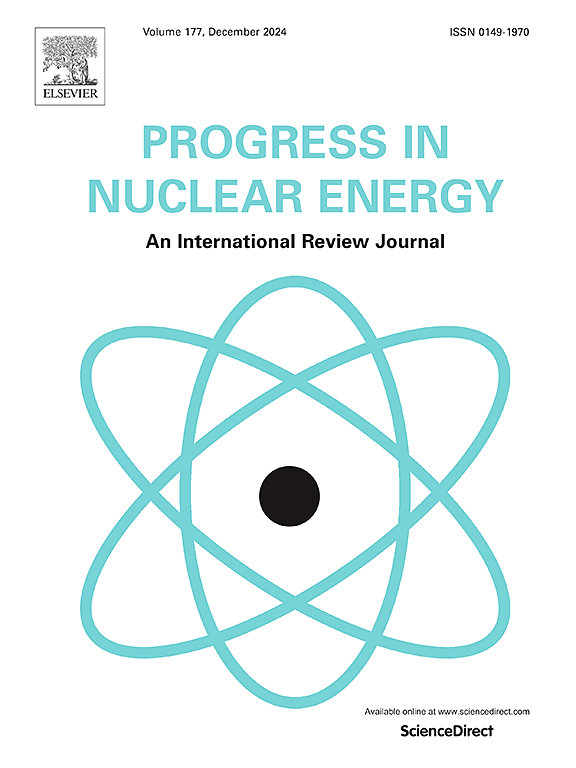Phenomena Identification and Ranking Table (PIRT) for heat pipes
IF 3.3
3区 工程技术
Q1 NUCLEAR SCIENCE & TECHNOLOGY
引用次数: 0
Abstract
Heat pipes are advanced passive thermal management devices that utilize phase change and capillary action to achieve efficient heat transfer. However, due to the complexity of the phenomena coupled in heat pipes, including capillary, phase change, turbulence, and compressibility effects, there are high uncertainties in the predictability of their operational regimes and performance. This PIRT exercise, conducted as a collaborative effort involving the Department of Energy (DOE) Microreactor Program (MRP), the Nuclear Regulatory Commission (NRC), and university partners systematically identifies, reviews, and prioritizes critical phenomena affecting the operation of heat pipes based on their importance and knowledge levels. Additional analyses and discussions are provided for phenomena with high importance and low knowledge, such as wick de-wetting, critical heat flux, contact angles, and pressure dynamics. The discussions include recognizing challenges and proposing future research directions for both modeling/simulation and experimental efforts. Additionally, the article addresses phenomena with medium importance and low knowledge that could impact heat pipe operation during non-normal or transient conditions, including frozen startup, laminar to turbulent transition, geyser boiling, wick priming, under-filling conditions, surface roughness of the wick, non-condensable gases trapped in the wick, and the timescales of startup and shutdown. This comprehensive evaluation serves as a valuable resource for guiding future research and development efforts, supporting the successful integration of heat pipes into nuclear reactors, and contributing to the advancement of heat pipe technologies in safety-critical industries.

热管现象识别与排序表(PIRT)
热管是先进的被动热管理装置,利用相变和毛细作用来实现有效的传热。然而,由于热管中耦合现象的复杂性,包括毛细、相变、湍流和压缩效应,它们的运行状态和性能的可预测性存在很大的不确定性。这项PIRT演习是由美国能源部(DOE)微反应堆计划(MRP)、美国核管理委员会(NRC)和大学合作伙伴共同开展的,根据其重要性和知识水平,系统地识别、审查和优先处理影响热管运行的关键现象。此外,还对一些重要但知识含量低的现象进行了分析和讨论,如灯芯除湿、临界热流密度、接触角和压力动力学。讨论包括认识挑战和提出未来的研究方向建模/仿真和实验工作。此外,本文还讨论了在非正常或瞬态条件下可能影响热管运行的中等重要性和低知识的现象,包括冻结启动、层流到湍流过渡、间歇泉沸腾、芯注入、欠填充条件、芯的表面粗糙度、芯中捕获的不可冷凝气体以及启动和关闭的时间尺度。这项综合评估是指导未来研究和开发工作的宝贵资源,支持热管成功集成到核反应堆中,并有助于在安全关键行业中推进热管技术。
本文章由计算机程序翻译,如有差异,请以英文原文为准。
求助全文
约1分钟内获得全文
求助全文
来源期刊

Progress in Nuclear Energy
工程技术-核科学技术
CiteScore
5.30
自引率
14.80%
发文量
331
审稿时长
3.5 months
期刊介绍:
Progress in Nuclear Energy is an international review journal covering all aspects of nuclear science and engineering. In keeping with the maturity of nuclear power, articles on safety, siting and environmental problems are encouraged, as are those associated with economics and fuel management. However, basic physics and engineering will remain an important aspect of the editorial policy. Articles published are either of a review nature or present new material in more depth. They are aimed at researchers and technically-oriented managers working in the nuclear energy field.
Please note the following:
1) PNE seeks high quality research papers which are medium to long in length. Short research papers should be submitted to the journal Annals in Nuclear Energy.
2) PNE reserves the right to reject papers which are based solely on routine application of computer codes used to produce reactor designs or explain existing reactor phenomena. Such papers, although worthy, are best left as laboratory reports whereas Progress in Nuclear Energy seeks papers of originality, which are archival in nature, in the fields of mathematical and experimental nuclear technology, including fission, fusion (blanket physics, radiation damage), safety, materials aspects, economics, etc.
3) Review papers, which may occasionally be invited, are particularly sought by the journal in these fields.
 求助内容:
求助内容: 应助结果提醒方式:
应助结果提醒方式:


